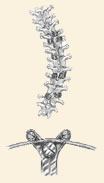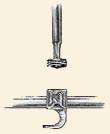Posterior Approach

Incision

Hooks, Screws &Rod Placement

Final Tightening
What is it?
There are different techniques and methods used today for scoliosis surgery. The most frequently performed surgery for idiopathic adolescent scoliosis involves posterior spinal instrumentation with fusion. This kind of surgery is performed through the patient’s back while the patient lies on his or her stomach.
Why is it done?
The Posterior approach was designed to correct the abnormal curves in the spine that occur in the condition known as "scoliosis." The posterior approach is the most traditional approach to the spine for spinal surgery. The majority of spinal operations are done using this approach.
The Operation
The first thing that happens after you enter the operating room is that your anesthesiologist will help you to fall asleep. Once you are completely asleep, the anesthesiologist will place a breathing tube to assist with your breathing during surgery, establish a variety of catheters in your veins, and often an arterial catheter in your wrist, all of which allow for monitoring of heart function, blood pressure, fluid status, and the depth of anesthesia during your operation. This allows the anesthesiologist to be sure that you remain completely asleep during the operation. Once this is accomplished, the patient is placed on their stomach and their arms and legs carefully padded.
The Incision
An incision is made down the middle of the back. The location and length of the incision depend on the location of the curve and the extent of the exposure that are required to correct it. The incision is often made slightly longer than the length of the planned fusion.
Hooks, Screws and Rod Placement
Correction of the scoliosis requires that the surgeon be able to "grab on" to the spine . There are a variety of ways to do this. Technically, the surgeon may choose to use hooks that attach to the back of the spine on the lamina, pedicle screws that are placed into the pedicle in the middle of the spine, wires, or other devices. Once these connection points are established, then a rod that has been bent or contoured into a more normal alignment for the spine can be attached and correction performed.
Final Tightening
When all of the implants are securely in place a final tightening is done.
Incision Closure
The incision is closed and dressed. Some surgeons may choose to place a drain into the wound after the surgery to protect the incision. Patients wake up in their hospital bed lying on their back.
 Menu
Menu









